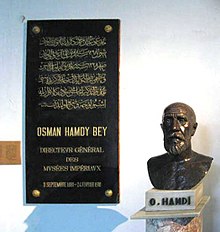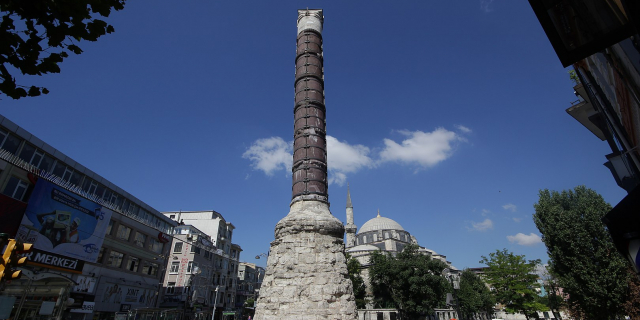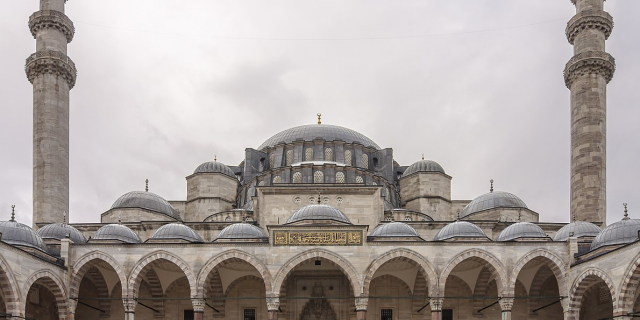The Istanbul Archaeology Museums (Turkish: İstanbul Arkeoloji Müzeleri) are a group of three archaeological museums located in the Eminönü quarter of Istanbul, Turkey, near Gülhane Park and Topkapı Palace. These museums house over one million objects from nearly all periods and civilizations in world history.
The Istanbul Archaeology Museums consists of three museums:
- Archaeological Museum (in the main building)
- Museum of the Ancient Orient
- Museum of Islamic Art (in the Tiled Kiosk).
 Bust and memorial plaque to Osman Hamdi Bey in the foyer of the main building
Bust and memorial plaque to Osman Hamdi Bey in the foyer of the main buildingDue to space constraints, the museum and its collection was transferred to the Tiled Kiosk (Turkish: Çinili Köşk) between 1875 and 1891. Commissioned by Sultan Mehmed II in 1472 as a pleasure palace, it is the oldest non-religious Ottoman structure in Istanbul and retains a visible Persian influence in its style and architecture[1] It was first opened to the public in 1953 as the Fatih Museum, to showcase Turkish and Islamic art, and was later incorporated into the Istanbul Archaeological Museum.
Appointed to the role in 1881, the first curator and founder of the museum was Osman Hamdi Bey, Painter, Archeologist and son of Ibrahim Edhem Pasha, an Ottoman Grand Vizier. An accomplished artist, in 2019 his painting "Girl Reading the Quran" sold for 6.3 million British pounds, making it the most expensive Turkish painting at that time.[2]
Throughout the 19th century, the existing importance given by the European states to historical artifacts gradually began to be understood by the Ottoman Empire as well. Thereunto arose the issue of establishing a method of regulating these cultural assets. Up to that point in time, 'historical artifacts' in the Ottoman Empire were subject to the common principles of fiqh (Islamic Law). The absence of specific regulations for preserving historical artifacts in effect created a legal void surrounding aspects such as the definition of historical artifacts, along with where and how they would be preserved.[3]
This changed in 1869, when the first set of laws were enacted that outlined the regulation of antiquities. Modern conservation experts refer to this as the first 'protection law' issued by the Ottoman State, focusing on permissions to carry out excavations and related artifact management. According to this law, the owner of land on which an excavation was conducted could claim possession of the finds discovered. While it was illegal to take such relics abroad, they could be bought and sold within domestic borders and the state held the principal right to buy them.[4] With this imperial decree for protecting cultural goods now being enforced, provincial governors throughout the Ottoman Empire would send in found artefacts to the capital city, thus further growing the collection.
With subsequent major finds being discovered shortly thereafter (e.g. excavation of the necropolis of King Sidon in modern-day Lebanon), it soon became clear that a purpose-built building large enough to house the growing museum collection was required.
 Pediment of Istanbul Archaeological Museum, with Ottoman Turkish اثار عتيقة موزسي "Asar-ı Atika Müzesi" (Museum of Antiquities), and the tughra of Abdulhamid II
Pediment of Istanbul Archaeological Museum, with Ottoman Turkish اثار عتيقة موزسي "Asar-ı Atika Müzesi" (Museum of Antiquities), and the tughra of Abdulhamid IIThe construction of the main building was started by Hamdi Bey in 1881, with its official opening held on June 13, 1891. The architect was Alexander Vallaury (who also designed the Pera Palace Hotel in Istanbul). The facade of the building was inspired by the Alexander Sarcophagus and Sarcophagus of the Mourning Women, both housed inside the museum. The inscription in Ottoman Turkish on the pediments of the gates at the entrance of the museum says "Asar-ı Atika Müzesi" (Museum of Antiquities). The tughra on the inscription belongs to Sultan Abdulhamid II. The building is considered by many as the preeminent example of neoclassical style architecture in Istanbul. Upon its 100th anniversary in 1991, the museum received the European Council Museum Award, particularly for the renovations made to the lower floor halls in the main building and the new displays in the other buildings.
The Museum of the Ancient Orient was commissioned by Osman Hamdi Bey in 1883 as a fine arts school. Then it was reorganised as a museum, which opened in 1935. Collections are relating to Anatolian (Early Bronze Age, Assyrian Colony Period, Hittite, Neo-Hittite, Urartian, Aramean), Mesopotamian, Egyptian, Syrian, Iran, Palestinian and Ancient Arabian. Egyptian collection is c.1,200 items that in all kinds of Egyptian Art artifacts. Most of them had come from Dra Abu al Nagar excavations near Karnak excavated by Gautier in 1891. Others are gifts of Hıdivs of Egypt and Ottoman officers. Mesopotamian artifacts are 10,000 pieces that came from Assur, Nippur, Lagaş, Girsu, Uruk, Şurupak, Sippar, Niniveh excavations. Palestinian objects are from Tell Gezer, Tell Zakarijah, Tell el-Hesi, Tell Taannek, Tell Sandahanna, Megiddo and Jericho excavations in Ottoman times. Some Susa vases were purchased from French excavators.


































Add new comment